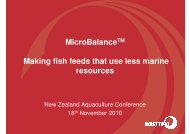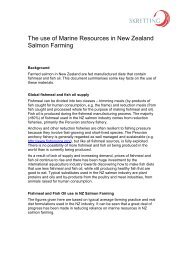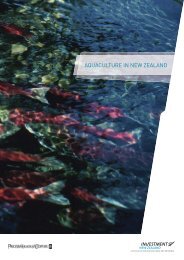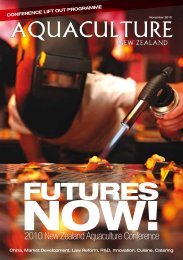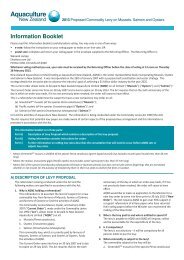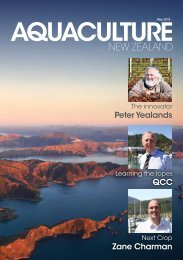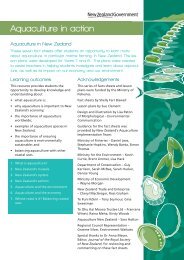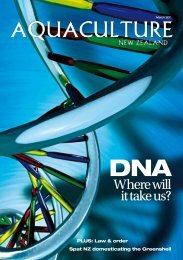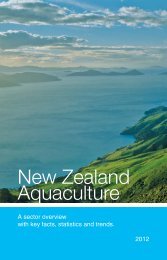Norman Ragg - Aquaculture New Zealand
Norman Ragg - Aquaculture New Zealand
Norman Ragg - Aquaculture New Zealand
Create successful ePaper yourself
Turn your PDF publications into a flip-book with our unique Google optimized e-Paper software.
Cellphones OFF<br />
please!<br />
NZ <strong>Aquaculture</strong> Conference 2010<br />
RESEARCH BASED SOLUTIONS
listen<br />
How to talk to shellfish<br />
The role of physiological tools in developing a<br />
deeper understanding of animals in aquaculture<br />
<strong>Norman</strong> <strong>Ragg</strong> & Ellie Watts<br />
NZ <strong>Aquaculture</strong> Conference 2010<br />
RESEARCH BASED SOLUTIONS
Quantitative<br />
understanding<br />
Talk<br />
&<br />
listen<br />
communicat<br />
e<br />
Qualitative<br />
understanding<br />
Appreciation &<br />
empathy
Animal husbandry:<br />
the importance of empathy and intuition
The enigmatic shellfish<br />
Animals in aquaculture<br />
tend to reveal little about<br />
their welfare
Our form of communication:<br />
Physiology… Getting beneath the shell<br />
‘fitness’ (capacity to cope with stress) determined by:<br />
-Resting/exercising heart rate and oxygen consumption<br />
-Blood cell responses and biochemistry
<strong>Aquaculture</strong> physiology at Cawthron<br />
Shellfish physiology lab 2010
Diverse interests…<br />
<strong>New</strong> species:<br />
•Establishing basic<br />
requirements<br />
Stress - cause & effect, e.g.:<br />
•Optimising handling and harvesting<br />
methods<br />
•Identifying critical environmental tolerance<br />
limits<br />
•Effects of disease<br />
Matching animal to environment<br />
–either:<br />
•Modify conditions in land-based systems<br />
•Site selection for grow-out<br />
•Species selection<br />
•Appropriate phenotype (family) selection<br />
Selective breeding -<br />
identify family lines that:<br />
•Optimise growth efficiency<br />
•Resilient to stress<br />
Climate change:<br />
•Real effects<br />
•Perceived effects
HSP genotyping<br />
Shell strength<br />
Fouling resistance<br />
Fluctuating asymmetry<br />
Stressor vs. histological changes<br />
heritability<br />
Stressor vs. immune function<br />
Stressor vs. survival<br />
simplification<br />
thermotolerance<br />
Feeding<br />
performance<br />
Growth<br />
performance<br />
Protein / lipid /<br />
carbo turnover<br />
Dynamic<br />
Energy<br />
Budgets<br />
Correlation to<br />
commercial<br />
performance
Temperature tolerance and the heart<br />
• Inescapable<br />
• Key determinant of growth rate, efficiency and condition<br />
• High temperature stress survival during seeding &<br />
harvest<br />
• Low temperature tolerance shelf life in live product<br />
• Etc..etc…<br />
• Heart-beat: vital physiological process directly<br />
affected by temperature<br />
Nasty graphs and algebra…
Calculating Arrhenius temperature<br />
S. Arrhenius 1889:<br />
k & ( T )<br />
= k &<br />
1<br />
e<br />
( T<br />
A<br />
/ T<br />
1<br />
−T<br />
A<br />
/ T )<br />
family #1<br />
Here k = heart rate<br />
So gradient Ln k : 1/T gives –T A , Arrhenius temperature<br />
Ln (heart rate)<br />
5.0<br />
4.0<br />
3.0<br />
-T A<br />
2.0<br />
1.0<br />
0.0<br />
0.0031 0.0032 0.0033 0.0034 0.0035 0.0036<br />
1/absolute temp (K -1 )
How to measure heart rate
• 24 mussel heart monitor setup
Futures now…<br />
intended outcomes
Relative family performance (preliminary conclusions)<br />
Family no. Growth Air survival Temperatur<br />
e sensitivity*<br />
Upper temp<br />
tolerance<br />
1 + + + +<br />
11 + - + -<br />
19 + - - -<br />
24 + - - -<br />
32 - + + +<br />
33 - - - -<br />
35 - + 0 +<br />
36 - + + +<br />
* + = less sensitive
Acknowledgements<br />
• Cawthron <strong>Aquaculture</strong> & Aquatic Biotechnologies group<br />
• Staff at the Glenhaven <strong>Aquaculture</strong> Centre<br />
• Andy Elliot, Bridget Alexander (Aotearoa Seafoods Ltd)<br />
• Dan McCall (Marlborough Mussel Co.)<br />
Funded by NZ Govt. Foundation for Research, Science &<br />
Technology grants to Cawthron (contracts CAWX0303,<br />
CAWX0802)
Slide Title Here – Arial 32
Survival in air<br />
• 24 families (2009 cohort)<br />
• 10 individuals x 4 containers<br />
• 18ºC, 97% RH<br />
• LT 50 determined by shell palpation
Results – survival in air<br />
Fast growing<br />
Slow growing<br />
9<br />
8<br />
mean survival (d)<br />
7<br />
6<br />
5<br />
4<br />
3<br />
1 2 3 4 5 6 7 8 10 11 12 13 14 19 20 22 24 27 30 31 32 33 35 36<br />
family no.



